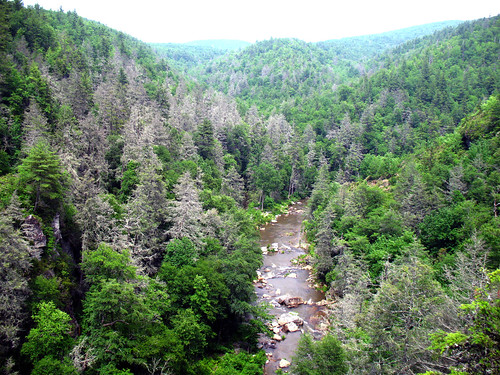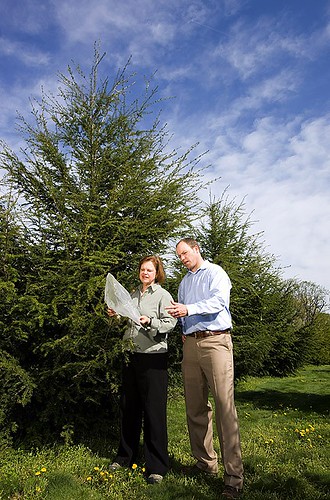
Residents of the Appalachian Mountains of the eastern United States have long enjoyed a rich culture of storytelling. Often rooted in a deep connection to the natural world, stories from Appalachian folklore serve to entertain as well as to educate; sometimes, important life lessons emerge, especially from tales of demise. A present-day ghost story from the southern Appalachians has captured the attention of U.S. Forest Service researchers who are using high-tech tools to follow the footprints of lost life.
The ghosts in this story are eastern and Carolina hemlock trees. Hemlocks provide valuable ecosystem services in Appalachian forests, including cover for wildlife and cooling shade along waterways. But they are being killed in increasing numbers by an exotic invasive insect, the hemlock woolly adelgid. Native to Asia, the hemlock woolly adelgid is transported through forests by animals, wind and, accidentally, by people. Often called “gray ghosts” because of their pale, skeleton-like appearance, the dead hemlocks are obvious across the mountain landscape. Using a forest monitoring tool known as ForWarn, scientists are able to see just how devastating the hemlock losses have become across the southern Appalachians, where the hemlock woolly adelgid thrives in the warmer temperatures. Here, the hemlock woolly adelgid is killing trees much more quickly than in the more northern areas of the hemlocks’ range, sometimes in as few as four years after infestation.
Every week, ForWarn delivers maps showing levels of forest vegetation greenness across the nation. The maps are based on satellite imagery, and provide important information about the health and development of forests compared to conditions from the previous year, the last three years and the past decade. ForWarn operates year-round, and is able to distinguish deciduous and evergreen vegetation. Because hemlocks are evergreen, their decline and death are most noticeable during the winter months. In locations where losses from dead and dying hemlocks are extensive, ForWarn maps show an overall decline in forest greenness during the growing season as well.
“With ForWarn, we’ve studied the onset, rate and severity of hemlock decline. What’s truly staggering is how rapidly southern Appalachian forests are changing due to the losses of these trees,” says Bill Hargrove, a research ecologist with the Eastern Forest Environmental Threat Assessment Center and lead ForWarn researcher. “While these rapid losses make it difficult for land managers to protect hemlocks in all areas, ForWarn can reveal where trees are declining so that managers can make informed decisions about prioritizing areas for on-the-ground monitoring and management.”
As researchers and land managers focus on the casualties of the hemlock woolly adelgid, something can be learned from this ghost story. “ForWarn has improved our understanding of the impacts of insect pests and other disturbances on our forests,” says Hargrove. “Perhaps the widespread damage caused by the hemlock woolly adelgid example serves as a cautionary tale: everyone must play a part in preventing the introduction and spread of destructive invasive species.”
April is Invasive Plant, Pest, and Disease Awareness Month. Learn more about the Forest Service Research and Development Invasive Species Program.

